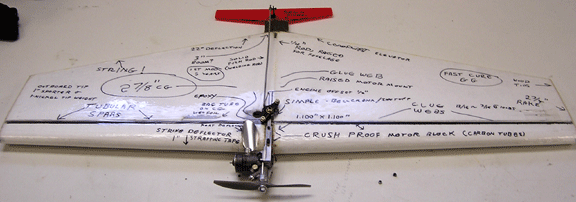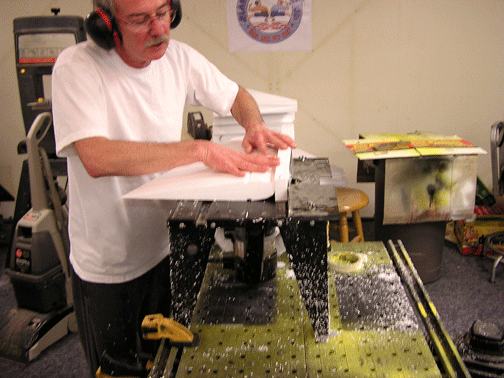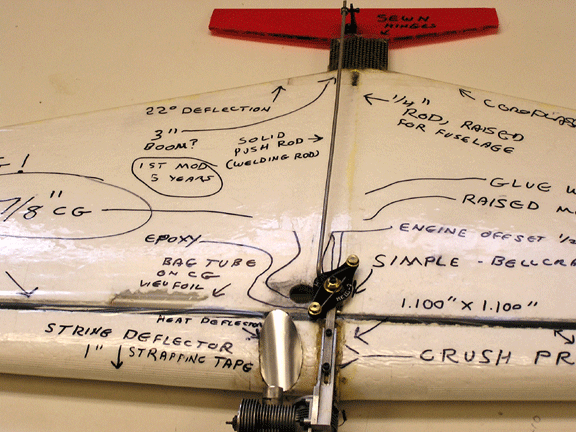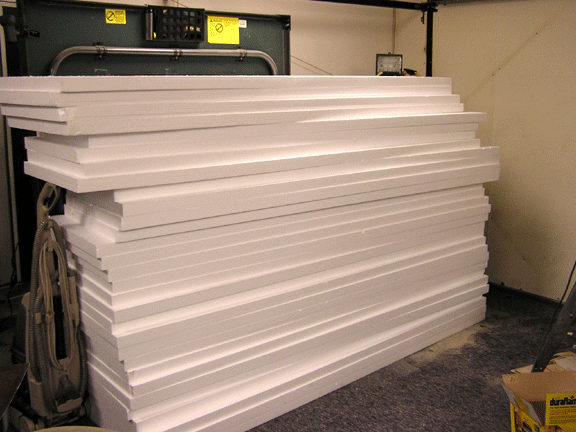

Top side of the R&B Rip-Off combat plane. Broadway Bod Busters photos.
There are three versions of the R&B. F2D, Fast and Speed Limit. This report will focus on the speed limit version of the platform. In the Northwest speed limit is an 80 mph event.
The name (Rein & Burdick Rip-Off) is derived from the many good ideas that both Jeff and I have observed in other combat wings. We borrowed from 1/2A, F2D and Fast designs to create the latest version of the R&B.
Since the combat clinic held at Chehalis 2008, we have received many questions about The R&B. It seems the more you answer, the more questions pop up. I am not equipped to draw and detail the plane so the best I can do is a drawing donated by Dave Seigler and a little history along with pictures.
"To borrow from one is plagiary, right! To borrow
from many is research."
~Bud Shank, The La 4
The R&B Rip-Off started life as a foam copy of Louet Wakkermans third
edition of his F2D airplanes. I was working with Jeff Rein in his shop but
he was having none this project.  In those days (2000),
he was on a Fast Combat roll and had made large inroads into the national
combat scene, F2D was a minor blip on his radar. Meanwhile, back at the
bench, I was learning just how difficult making a good one of these things
can be. I would change one moment and throw the entire thing out of kilter,
new CG, New back end, new motor block, change the spar location, it was
a never ending stream of variables. It may have been the fifth edition when
I became frustrated and peaked The Rein Man's curiosity. What's wrong
with it? He asked, EVERYTHING! I shouted back, How hard can
it be? You screw with it! I bellowed.
In those days (2000),
he was on a Fast Combat roll and had made large inroads into the national
combat scene, F2D was a minor blip on his radar. Meanwhile, back at the
bench, I was learning just how difficult making a good one of these things
can be. I would change one moment and throw the entire thing out of kilter,
new CG, New back end, new motor block, change the spar location, it was
a never ending stream of variables. It may have been the fifth edition when
I became frustrated and peaked The Rein Man's curiosity. What's wrong
with it? He asked, EVERYTHING! I shouted back, How hard can
it be? You screw with it! I bellowed.
By the following week he had reconfigured my foam templates to new ones (Jeff hard at work in photo at left). "I like that airfoil on the Baliev, he said, and I made it fatter in the chord. I looked and sure enough there was a set of foam cores cut to a different airfoil and completely different center and tip size.
We were trying all sorts of new ideas on the F2D ship. Holes in the wing,
vertical shear spars made out of 1/64 plywood, Aluminum arrow shaft booms,
angled motor blocks so the muffler would clear, cored out wings with foam
webs! The idea list rolled on like song stuck in your head. A problem was
that when we saved a few grams of weight, it would compromise the strength
to a fault. The flying was pretty close to the store bought F2D ship but
it was weak and could not take a hit or crash, the whole idea was to get
away from the exploding combat wings in F2D. In those days, you could just
nick the wing on a hot F2D ship and the covering would explode, while foam
could lose chunks and keep going. We were burned out with making intricate
hollow cores and tricky stuff, I abandoned the project as a good effort.
"It ain't over till we decide it's over!"
~John Belushi
Having seen my moderate success using Wakkerman F2D ships in speed limit,
Jeff set out to convert the Failed F2D ship into a speed limit wing. He
showed me a new core. "Got no holes" he said. See?
and he held up the familiar platform of the R&B. No tricky spars, just
plain old 1/8" x 3/8" spruce.  The engine
block was longer and the boom slightly further back. Controls were put on
the top of the wing into a little recess like a Texas 1/2A ship. We test
flew it and eliminated the F2D features of turn on a dime, cut 1" off
the outboard wing instead of the 2" and presto! There was awesome flying
speed limit model.
The engine
block was longer and the boom slightly further back. Controls were put on
the top of the wing into a little recess like a Texas 1/2A ship. We test
flew it and eliminated the F2D features of turn on a dime, cut 1" off
the outboard wing instead of the 2" and presto! There was awesome flying
speed limit model.
The first year or two of flying it was a learning experience of engine tuning. Jeff was flying his old and slow PC1 going a full blown 73 mph against 80 mph wings. The airplane however, flew so superior that he won most all matches. We placed side bets during contests as to who he could shake into the ground. The faster "big iron" ships would chase the R&B down, but it would suddenly change directions a few feet off the ground leaving the modern OS .25 or .36 ship lawn darted into the turf.
We then used better engines that we had left over from our F2D adventures,
some too fast and others too slow. The best all around engine seems to be
the Cyclon PC6, it runs right at 80 with streamer on a 7x3 APC prop on 10%
fuel, and all you need do is bolt it on. Other .15's could be used, but
the best overall quality is found in true racing engines. The F2D motors
are very light as well as fast. The venerable H&R
shut-off was mounted on a bar of 7075 aluminum that bolts on with the
engine mounts, making it portable with the engine.
Okay, so much for history, here it is. I have construction pictures that should give you a very good idea of how to make one if you chose to do so. We never intended to publish this model, it was made for our use only but it has been a very successful combat wing.
 Center boom: 1/4" fiberglass
kite tube offset to exit wing on top of the stabilizer platform for trength.
(Photo at right.)
Center boom: 1/4" fiberglass
kite tube offset to exit wing on top of the stabilizer platform for trength.
(Photo at right.)
 Engine notch: Foam notched for engine block on outboard
foam core only, the block should be flush when set in notch, the same
applies to the boom tube.
Engine notch: Foam notched for engine block on outboard
foam core only, the block should be flush when set in notch, the same
applies to the boom tube.
Note: Contact Jeff Rein for routed cores.
The drawing is not scale.
The spar location is not correct on the drawing as is the leading edge sweep. The drawing was donated by the hard work of Dave Seigler who had no dimensions from us so please consider it just for reference.
This version of the R&B was designed to fly with a .15 at 80+ mph
on .015 dia lines. In a pinch I have substituted .018 lines with no problems.
Other heavier engines will work well if the CG is correct so O.S .25 and
a big ol .36 will also be fine.  The R&B will fly
as well at lower speeds (75 mph) but has been tuned to our event in the
Northwest. Because we use a shutoff's, we must have the wing trimmed correctly
or lose line tension at some point and the shutoff will do its thing. (R&B
equipped with H&R shutoff in photo at right.)
The R&B will fly
as well at lower speeds (75 mph) but has been tuned to our event in the
Northwest. Because we use a shutoff's, we must have the wing trimmed correctly
or lose line tension at some point and the shutoff will do its thing. (R&B
equipped with H&R shutoff in photo at right.)
Fly it level, both upright and inverted. If the wing tips up or down at all, STOP! Correct the warp and test again. Control deflection is about 15-20 degrees in each direction, if this seems too tame, check the CG and correct with some tail weight. By having on the top controls, you can allow the bellcrank to move too far giving it too much control, stalling the wing and triggering a shut-off. As some of you witnessed in the Combat Clinic, this will not happen to a trimmed airplane, it will just continue to turn and burn. A handy way to help this is to Z bend the pushrod so it enters the bellcrank on the TOP, not the bottom. The last part of the Z bend will strike the bellcrank mounting bar limiting the up control.
If the wing jumps in on either consecutive inside or outside loops, the leadout position will need to move further back. If the wing "hinges" in the same maneuvers (looks like the outside wing is hanging down) move the leadout position forward. One very important thing we found is to have the lines run as tight to the wing as possible. This can be done by drilling a hole through the center of the wingtip angled upward so the lines exit on the top of the wing about 4" from the tip. This keeps them tight on the surface of the wing and prevents the outboard "tip up" condition of other control on the top designs.
As I said before, this wing was never intended to be published, just used by the two of us. It is designed in detail to a FORMULA that we want. If you make changes to it you may not get the desired results so try it this way before changing anything. All features have been put in the design for a reason, primarily through trial and error to make a better tool for us to use.
 As I am writing this, Jeff and I are building
100 cores and plan on using 40 of them ourselves.
As I am writing this, Jeff and I are building
100 cores and plan on using 40 of them ourselves.
If you have questions, you can contact either of us through Flying Lines and we will try to help.
-- Ken Burdick
This page was upated Feb. 19, 2009